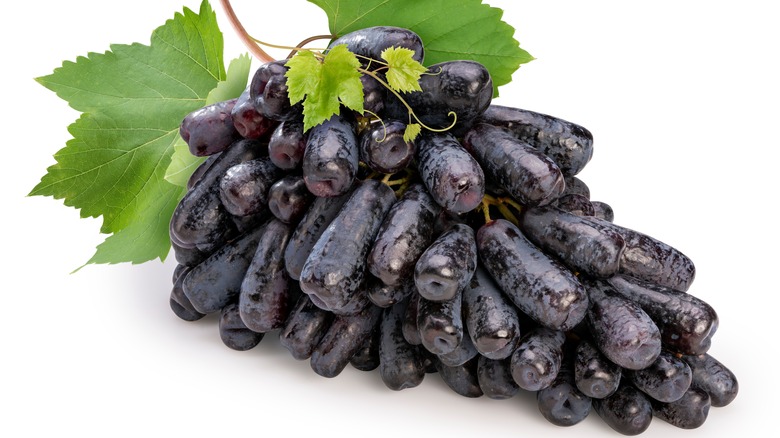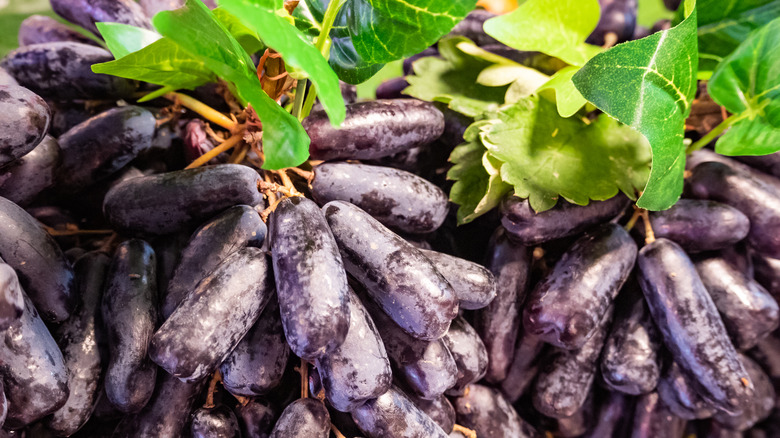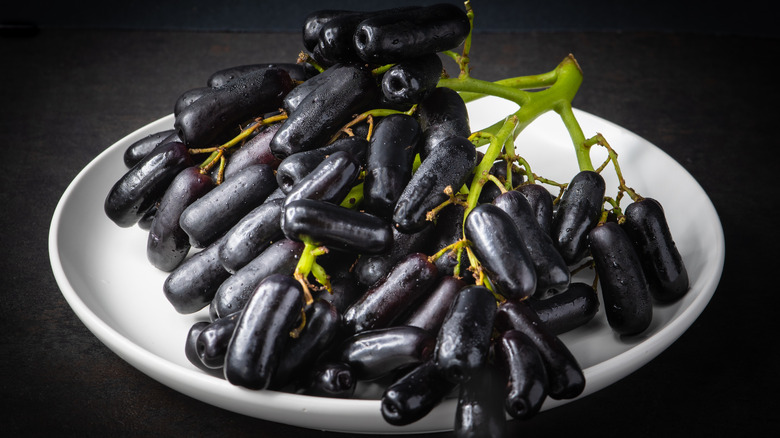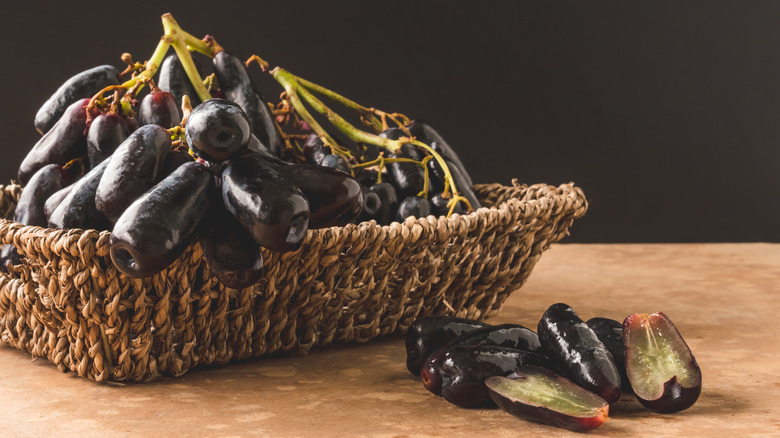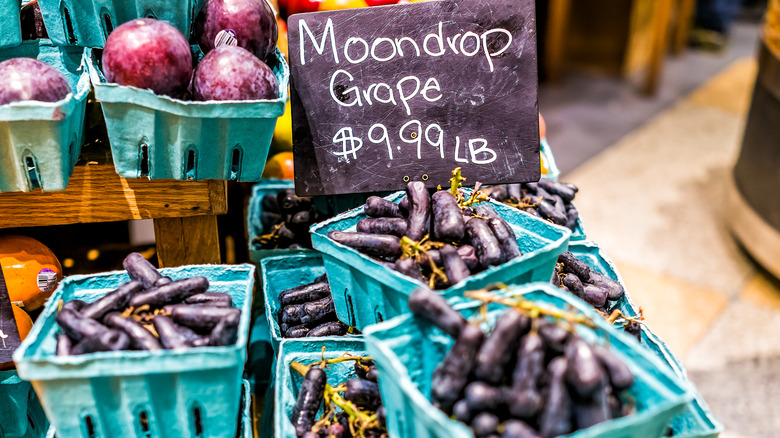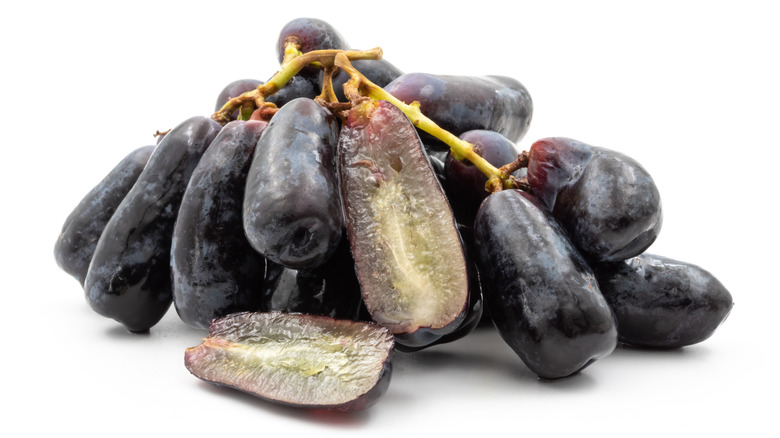The Unique Grape Variety That Took Nearly A Decade To Create
Given that, according to PinotFile, there are roughly 10,000-15,000 different kinds of grapes that fall under the Vitis vinifera species, you might think we can't possibly need more kinds of grapes. News flash: there are some mighty creative and dedicated plant breeders out there who vigorously disagree.
Under the umbrella of Vitis vinifera there are some pretty well-known grape varieties like Cabernet Sauvignon and Chardonnay, revered for producing some of the best wines in the world. But many table grapes are part of the Vitis vinifera club as well, and if you've been paying attention to the grape section of your produce department, you may have noticed a proliferation of different kinds of grapes for sale — with names like Cotton Candy or Gummyberry. While those utterly delicious grape varieties look pretty similar to other varieties you might have eaten as a child, albeit with a premium price tag, there's one grape variety that visually stands out from the rest, and that's the Moon Drop. What's so special about the Moon Drop grape? We're glad you asked.
The Moon Drop is luscious, long, and deep, deep purple
Also known as the Sweet Sapphire, or among breeders as the less-than-poetic IFG Six, the Moon Drop grape has a deep purple skin, a dimple in one end, and is visually distinct from most other table grapes you'll find — resembling something like a tiny eggplant.
The inky-colored grape is often covered in what Specialty Produce calls a "medium to heavy, blue-grey bloom," which looks almost like the grape has been dusted with powder. The bloom, which is completely harmless and edible, can be wiped away to reveal the shiny, glossy exterior of the Moon Drop that's beneath. These stunning little beauties might look too pretty to eat, but you'd be missing out passing on them. They're the product of years of work, all aimed at making the grapes not only lovely to look at, but also irresistibly delicious. Pretty as they are, you won't find them depicted in Romantic-era still-life paintings, so where did these grapes come from?
Moon Drops are a collaborative effort
Moon Drop grapes, like Cotton Candy grapes, were developed by International Fruit Genetics (IFG) in collaboration with Grapery, according to Specialty Produce. The entire process of bringing a grape to market is a lengthy one, and co-founder of IFG, David Cain told NPR that it takes somewhere between 6 and 15 years to accomplish.
There's no genetic engineering going on at IFG; it's just old-fashioned selective breeding that led the team to develop a hand-pollinated cross between the Beita Mouni grape and a variety known only as C22-121, resulting in the Moon Drop, first created in 2004 and patented in 2013.
Both IFG and Grapery, which share a founder in grapevine expert, Jack Pandol, focus their work on developing grape varieties bred for both flavor and shape, filling a gap in the marketplace that had previously seen varieties selected for their ability to "withstand shipping and storage," as David Cain explained to NPR.
What do Moon Drop grapes taste like?
Moon Drop grapes are super-crisp, and Specialty Produce says their firm texture, coupled with their elongated shape means you can actually snap them in half! Moon Drops are very sweet, with a nearly-clear flesh and perceptible tannins that help balance the sweetness beautifully. They taste a bit like the best grape jelly you can imagine.
Grapery boasts that all their grapes are harvested when they're perfectly ripe, and that might just sound like lip service, but this company means it. Each grape variety is harvested multiple times to ensure that each bunch of grapes in the market is fully ripe, which, at least in part, explains why they may be pricier than other grape varieties. Moon Drops have a delightfully tangy flavor that's only demonstrated by fully ripened grapes. How crazy are the folks at Grapery? So crazy that Specialty Produce points out that Moon Drop grapes are covered with plastic while they're on the vine to protect thems from the rain while they ripen. Ripe, sweet, tangy, and crisp ... sure, you can eat 'em by the handful, but how else can you use Moon Drop grapes?
How do you put Moon Drops to work in the kitchen?
While kiddos would love Moon Drops for a snack or as part of their school lunch, there are definitely grownup applications as well. They're both tasty and dramatic on a charcuterie plate, where the crisp texture is a definite benefit and the perfect foil for salty cheeses and cured meats. Sliced Moon Drops would definitely dress up our recipe for Waldorf salad with candied walnuts as well.
You're not just limited to raw applications for Moon Drops; try the grapes on a pizza, perhaps paired with crispy prosciutto and a little crumbled gorgonzola cheese. Should you end up with more Moon Drops than you'd anticipated, there's always grape jam or jelly to use up those beautiful grapes before they're over the hill. And one of our favorite grape secrets — the perfect way to play up the sweet-tangy balance of Moon Drops — is to pickle grapes for use either with charcuterie or sliced and layered on a sandwich for a zingy kick.
Where can you find Moon Drop grapes?
Moon Drops are grown in California, in the San Joaquin Valley, chosen by IFG and Grapery for its ideal combination of sun, soil, and climate. In a statement sent to Tasting Table, IFG shares the grapes can be found across the world. If you're looking for a specific store to purchase the grapes, Grapery has an interactive map to help you in your search, with locations in the U.S. and Canada. Stores the grapes can be found include Harris Teeter, Trader Joe's, Wegman's, Giant, Safeway, Whole Foods, Kroger, and Albertson's.
Because the process of developing varieties like Cotton Candy and Moon Drop grapes is so lengthy, those varieties are proprietary, and according to IFG, there's a global legal team that oversees licensing their varieties to growers. They "take defending the investments and the rights of our growers very seriously." That means, according to Specialty Produce, that you can't even grow Moon Drop grapes in your backyard, even for personal use. The patent for the grape variety doesn't expire until June of 2031, so DIY-ers have a bit of a wait to grow their own.
How do Moon Drops stack up, nutritionally?
Roughly 10 grapes, or 49 grams of Moon Drops contain 34 calories, almost no fat, no cholesterol, just 1 milligram of sodium, 8.9 grams of carbohydrates, .4 grams of fiber, 7.6 grams of sugar, and .4 grams of protein, along with a small amount of both iron and potassium, roughly 1-2% of the RDA for those nutrients.
Moon Drops are nutritionally very similar to other grapes grown by any other producer, and they're a good source of copper, vitamin K, B vitamins, and may help reduce both blood pressure and cholesterol. Grapes are also rich in antioxidants like anthocyanins, resveratrol, quercetin, beta carotene, and vitamin C. In short, Moon Drops, just like other grape varieties, are an easily accessible way to round out a healthy diet.
So perhaps we didn't really need a new grape variety, but Moon Drops are exceptionally tasty, gorgeous to behold, and are certainly a delicious addition to the Vitis vinifera family.
